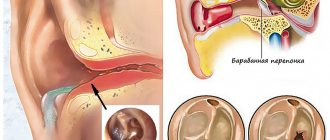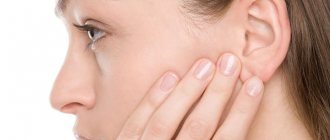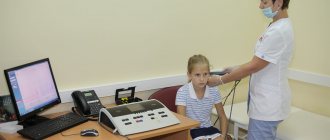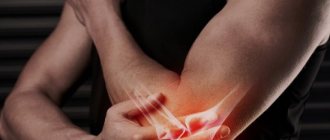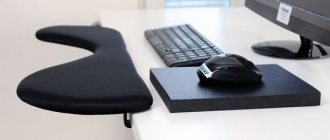A ruptured eardrum is a hole in the thin tissue that separates the ear canal from the middle ear.
Author:
- Borzenkova Inna Andreevna
otolaryngologist
3.76 (Votes: 17)
- Diagnostics
Section: symptoms and causes
Review
A tympanic membrane rupture (or tympanic membrane perforation) is a hole or tear in the thin tissue that separates the ear canal from the middle ear.
A rupture can lead to hearing loss and also make the middle ear vulnerable to infection or injury.
Perforation of the tympanic membrane usually heals within a few weeks without treatment. Sometimes, however, a ruptured eardrum requires surgery to close. The middle and inner ear consist of delicate mechanisms that are sensitive to injury and disease. Prompt and correct treatment is important to preserve hearing.
Signs of eardrum damage
When the eardrum is damaged, a person feels a sharp, characteristic ear pain. After some time, the pain subsides, but the person continues to complain of a sharp decrease in hearing and noise in the ear (or a feeling of ear congestion). If the damage to the eardrum was so severe that it ruptured, then the person may also feel the release of air from the side of the injured ear. This happens when you sneeze or blow your nose.
It should be said that the severity of all clinical manifestations will, first of all, depend on the degree of damage to the eardrum. If the damage was minor and affected only the outer layer of the eardrum, then this will not lead to hearing loss. The latter will be characterized by rapid regression of pain. But, if we are talking about extensive damage to the eardrum, then a fracture of the auditory ossicles or rupture of the joints is assumed. In practice, injury to the internal muscles located in the middle ear cavity also occurs. However, most often there is a rupture of the joints (for example, the incus), as well as a fracture of the base or legs of the stapes. Impaired functioning of the auditory ossicular system can lead to the formation of conductive hearing loss. Intense noise in the ear and hearing loss are characteristic of fractures of the base of the stapes. In this case, various vestibular disorders are also possible, accompanied by leakage of perilymph from the ear cavity.
Causes
Causes of rupture or perforation:
- Inflammation of the middle ear (otitis media). A middle ear infection often causes fluid to accumulate in the middle ear. The pressure of this fluid can cause perforation.
- Barotrauma. Barotrauma is stress on the eardrum when the air pressure in the middle ear and the air pressure outside are out of balance. If the pressure is severe, the tympanic membrane may rupture. Barotrauma is most often caused by changes in air pressure associated with air travel. Other events that can cause sudden changes in pressure—and possibly rupture of the membrane—include scuba diving and a direct blow to the ear, such as a car airbag.
- Loud noises or explosions (acoustic trauma). A loud sound, such as an explosion or gunshot, or a blast—essentially an overwhelming sound wave—can cause the membrane to rupture.
- Foreign objects. Small objects such as a cotton swab or hairpin can puncture or rupture the tympanic membrane.
- Severe head injury. Severe trauma, such as a skull fracture, can dislocate or damage the structures of the middle and inner ear, including the eardrum.
Complications
The eardrum has two main functions:
- Auditory. When sound waves strike, the eardrum vibrates—the first step by which structures in the middle and inner ear translate sound waves into nerve impulses.
- Protective. The eardrum also has a barrier function, protecting the middle ear from water, bacteria, and other foreign substances.
Complications may occur as the membrane heals or if it fails to heal.
Possible complications:
- Hearing loss. Typically, hearing loss is temporary, lasting only until the tear or hole heals. The size and location of the tear can affect the degree of hearing loss.
- Inflammation of the middle ear (otitis media). A perforated eardrum allows bacteria to enter the ear. If a perforated eardrum does not heal or repair itself, you may be vulnerable to ongoing (chronic) infections that can cause permanent hearing loss.
- Middle ear formations (cholesteatoma). Cholesteatoma is a growth in the middle ear consisting of skin cells and other substances. All accumulated impurities and dead skin cells in the ear canals usually come out with earwax. If the membrane is ruptured, skin cells can pass into the middle ear and form a cholesteatoma. Cholesteatoma provides a favorable environment for bacteria and contains proteins that can damage the ossicles of the middle ear.
Prevention
Follow these tips to avoid tearing or perforation:
- Proper treatment of otitis media. Be aware of signs and symptoms of infection, including ear pain, fever, nasal congestion, and decreased hearing. Children with otitis media often have their ears touched or pulled. Contact your ENT doctor for an examination to prevent possible damage.
- Protect your ears during the flight. If possible, avoid flying if you have a pre-flight allergy that causes congestion. During takeoffs and landings, try to keep your ears open. This can be achieved by yawning or chewing gum. Or use the Valsalva maneuver - gently blow air through your nose, pinching your nostrils and closing your mouth. Stay awake during takeoff and landing.
- Do not clean with foreign objects. Do not try to deep clean earwax with cotton swabs, paper clips, or hairpins. These objects can easily rupture or puncture your eardrum. Teach your children about the consequences of putting foreign objects in their ears.
- Protection from excessive noise. Wear earplugs or headphones at work or while relaxing if there is loud noise.
Incidence (per 100,000 people)
| Men | Women | |||||||||||||
| Age, years | 0-1 | 1-3 | 3-14 | 14-25 | 25-40 | 40-60 | 60 + | 0-1 | 1-3 | 3-14 | 14-25 | 25-40 | 40-60 | 60 + |
| Number of sick people | 0 | 0 | 6.5 | 9.1 | 9.1 | 9.1 | 9.1 | 0 | 0 | 6.5 | 9.1 | 9.1 | 9.1 | 9.1 |
Section: diagnosis and treatment
Diagnostics
An ENT doctor can determine the presence of a ruptured eardrum by visual examination using a lighting device (otoscope, microscope or endoscope). Your doctor may do additional tests to determine the cause of the tear or the extent of the damage. These tests include:
- Laboratory tests. If there is discharge from the ear, your doctor may take a swab to look for a bacterial infection.
- Study with tuning forks. A tuning fork is a metal instrument in the form of a two-pronged fork that produces a sound when struck. Tuning fork studies help the doctor detect hearing impairment, determine whether it is due to perforation of the tympanic membrane, damage to the sensory cells of the inner ear, nerves, or damage to both.
- Tympanometry. A tympanometer is a device inserted into the outer ear canal that measures the eardrum's response to small changes in air pressure. Some answer choices may indicate perforation or rupture.
- Audiological hearing test. If these tests aren't enough, your doctor may order an audiology test, done in a soundproof booth, that shows how well you hear sounds at different volumes and pitches.
Diagnosis of eardrum damage
The primary diagnosis of a damaged eardrum is carried out by a traumatologist. The latter can be explained precisely by the fact that the damage is often associated with ear trauma. To establish a final diagnosis and determine the correct treatment, consultation with an otolaryngologist is necessary. An effective method for diagnosing damage to the eardrum is endoscopic examination, which includes otoscopy and microotoscopy. To determine the assessment of the indicators of the hearing aid, as well as the vestibular one, audiometry, tuning fork studies, threshold audiometry, electrocochleography, vestibulometry, stabilography and caloric test are performed. Bacteriological examination of ear discharge is carried out if damage to the eardrum is complicated by secondary infection.
Treatment
Most perforations heal without treatment within a few weeks. Your doctor may prescribe antibacterial drops if there are signs of infection. If the tear or hole in the membrane does not heal on its own, treatment will include procedures to close the perforation. These may include:
- Closure of the eardrum. If the tear or hole does not close on its own, the ENT doctor can close it with a special flap. This is an outpatient procedure in which the doctor freshens the edges of the wound to encourage growth and then places a flap over the hole. It may be necessary to repeat the procedure several times before the hole closes.
- Surgery. If the flap does not heal, or the doctor determines that the gap is unlikely to be closed with it, surgery is recommended. The most common surgical procedure is called tympanoplasty. The surgeon takes a tiny piece of your own tissue to close the hole in your eardrum. This procedure is performed on an outpatient basis, meaning you can go home the same day unless the anesthesia required requires a longer hospital stay.
Operation process
Myringotomy.
Photo: Dr Paulose FRCS - ENT SURGEON / YouTube The puncture of the eardrum is carried out in several stages:
- removal of wax from the ear canal;
- rinsing the ear with an antiseptic solution;
- administration of anesthetic;
- a linear incision of the eardrum with a sterile paracentesis needle;
- antiseptic treatment;
- installing a thick gauze swab (turunda) with medicine.
Lifestyle and recommendations
Perforation of the tympanic membrane usually heals on its own within a few weeks. In some cases, treatment requires several months. Until your doctor tells you that the tear has healed, take care of it by doing the following:
- line the perforated ear with a cotton ball and Vaseline when bathing;
- refrain from cleaning;
- Avoid blowing through the nose, as the pressure created when blowing through the nose can damage the healing eardrum.
What you can do before visiting your doctor
Make a list before your doctor's visit. Your list should include:
- the symptoms you are experiencing, including any symptoms, even those that may not seem related to your hearing loss;
- events that could cause ear problems, such as recent injuries or flights, inflammation of the middle ear;
- medications, including any vitamins or supplements you take;
- questions for your doctor.
If you think you have signs or symptoms of a perforated eardrum, you can ask your doctor the following questions:
- Is there a ruptured eardrum?
- What else can cause hearing loss and other symptoms?
- If I have a ruptured eardrum, what should I do to protect my ear while it heals?
- When should I come for a follow-up examination?
- At what point should we consider other treatments?
Ask any other questions you have.
